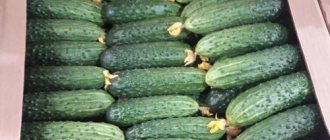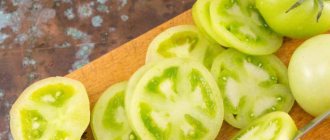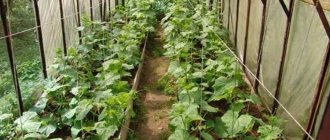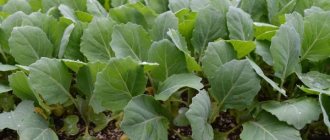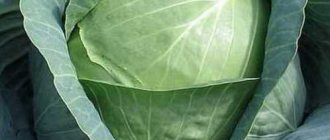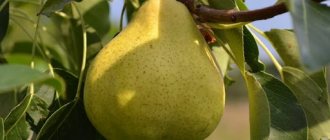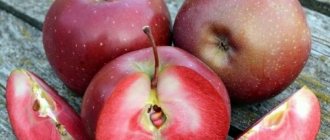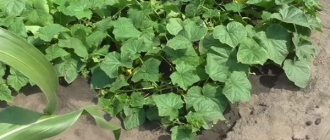Cucumbers are one of the most ancient agricultural crops. They appeared more than 6 thousand years ago and are even mentioned in the Bible. They grow wild as vines in the tropical rainforests of the Hindustan Peninsula. The fruits are small and bitter. And there is no comparison with the traditional vegetable of Russian cuisine. Crispy, tender, with soft skin - this is how you can characterize the greens of one of the modern varieties bred by Russian breeders. Phoenix - rising from the ashes. Why this name was given to an ordinary vegetable familiar to everyone from childhood and whether there are any peculiarities of growing this variety in our country can be found out in this article.
Characteristics and description of the variety
Phoenix is a variety that combines three varieties (640, Phoenix plus and Phoenix itself). Each has its own characteristics. Therefore, knowing their characteristics, you can choose the one you need based on yield, fruit length, and direction of use. But the methods of agricultural technology are common to everyone and do not require the use of any great effort or expense. Because the variety is quite unpretentious, bee-pollinated. Therefore, cucumbers are grown in open ground more often than in greenhouses.
Phoenix is a late-ripening variety. It takes about 2 months for the first harvest to appear after germination. But fruiting lasts until the first frost in open ground. The lashes are long, reaching up to three meters. Cucumbers have an oval-cylindrical shape and grow up to 15 cm. Weight is about 150 grams, but when overripe they weigh 200 grams. The color is emerald, matte with small whitish spines.
Phoenix plus – mid-season. That is, it will take a month and a half before the fruit appears. The length of the lashes is much shorter and the bush is more compact. Zelentsy are smaller in length and weight. Accordingly - 12 cm, 60 grams.
Cucumber fruits of the Phoenix Plus variety
In Russia, cucumbers have been grown since the 15th century. The German ambassador, traveling around the Moscow state at the beginning of the 16th century, mentioned them in his notes.
How is it different from Phoenix 604 and Phoenix-plus varieties?
The culture marked “plus” produces medium-sized fruits that can be pickled whole in jars, like gherkins.
Only the size of the fruits of this crop is larger, but in terms of their characteristics, cucumbers have the same parameters. This plant begins to bear fruit at 45-55 days.
Phoenix 604 can be recognized by the size of the fruit; this indicator is more likely to be considered average. It is rarely possible to grow a large cucumber on a plot. This only happens if you don’t remove it from the garden in time. The crop is classified as late-ripening, the fruits appear in 60-65 days. Some gardeners are confused by the large-fruited variety, for this reason they prefer Phoenix-plus cucumbers.
Features of the variety
The Phoenix variety never ceases to amaze even experienced gardeners with its characteristics. Until 1986, agricultural enterprises and amateur vegetable growers did not experience any problems producing cucumbers in open ground. But due to epiphytotics, which are massive plant diseases such as peronosporosis, bacteriosis and powdery mildew, the bushes died as soon as they began to produce their first fruits. But Phoenix survived. That’s why the former cucumber variety “640” was named after the legendary bird that rose from the ashes. Hybrids have been created on its basis.
Phoenix cucumbers were named after the mythical bird.
To breed ordinary varieties, you can collect the seeds yourself and then plant them on the site. Hybridization products do not have such features. In the second year, plants atypical for this hybrid will grow from seeds collected independently and sown, and the yield from the bushes will be low.
Country of origin, growing regions
The variety was created in the 80s at the breeding station in Krymsk (Krasnodar Territory). At first it was simply numbered 640. But after it withstood downy mildew, which destroyed the entire crop in the fields, it got its name - Phoenix. It was included in the State Register of the Russian Federation in 1993.
Phoenix Plus was created at the same scientific institution a little later and registered in 2005.
The Phoenix variety cucumber was created at a breeding station in the city of Krymsk
The variety is recommended for cultivation in open ground in temperate and southern Russia: Stavropol, Krasnodar Territories, Lower Volga Region, Central Black Earth Region. Indoors - in the more northern regions of the country.
In temperate climates, fruiting can be accelerated by using small shelters in early summer. Sow the seeds after the soil has warmed up to the desired temperature, and cover the plantings with film stretched over the arcs. After the onset of stable air temperature, it is removed.
Advantages and disadvantages
Phoenix begins to produce its first harvest two months after planting. And this is probably the main drawback in comparison with the same super-early varieties. But this variety has plenty of advantages. The main one is resistance against diseases of cucumbers characteristic of pumpkin plants (powdery mildew on cucumbers, mosaic spot). In addition, the variety is worth having on your site because it:
- Drought resistant;
- Tolerates temperature changes well;
- Has long-term fruiting until the first frost;
- High-yielding. Fruit shelf life up to two weeks;
- Has good taste. No bitterness.
Phoenix cucumbers are highly productive
It is intended not only for consumption raw, but can also be preserved in the form of gherkins. Although some gardeners claim that Phoenix Plus is not suitable for winter harvesting.
You can read about the best varieties of cucumbers for pickling and canning here.
Advantages and disadvantages of Phoenix cucumbers
This cucumber variety seems attractive and promising for many vegetable growers, especially in the southern regions. With minimal costs you can get a rich harvest.
The main advantages of the Phoenix variety:
- high productivity;
- frost resistance;
- long fruiting period;
- strong immunity;
- drought resistance;
- ease of care;
- long shelf life;
- marketable condition;
- ease of transportation;
- versatility of use in cooking;
- pleasant taste.
There are fewer disadvantages, but before growing Phoenix cucumbers you need to familiarize yourself with them in more detail:
- the appearance of bitterness during sudden temperature changes;
- limited growing conditions;
- big fruits.
Growing
This variety is from the undemanding category. But at the same time, it will thank the owner of the land with a high harvest if the rules of agricultural technology are strictly observed. Therefore it is necessary:
- Properly prepare the soil for planting;
- Prepare seeds and sow them at the right time;
- Since cucumbers respond well to soil fertility when growing, it must be maintained at a high level;
- These plants come from tropical rainforests, so they love moisture.
It is necessary to water the plant in a timely manner, preventing the soil from drying out.
When planning a plot for a particular crop in the fall, you need to know after which plants cucumbers can be planted, and after which it is not recommended. The thing is that plants of the same species use the same substances from the soil for nutrition and suffer from the same diseases. Therefore, the best predecessors for greens will be: peas, beans, soybeans, and corn. Growing potatoes and growing tomatoes in open ground is acceptable. For compact planting, you can plant onions on greens or turnips. On the sides of the cucumber are radishes. Cucumbers can tolerate some shade. Therefore, plantings can also be placed in the garden under trees that do not have a too thick crown.
Soil preparation
After the area for spring sowing of cucumber has been determined, the soil is prepared in the fall. Before loosening, collect all plant debris and place it in a compost pit.
Before planting cucumbers, all plant residues are placed in a compost heap.
It is best to add manure before digging. Up to 10 kg per square meter. If there is no organic fertilizer, then mineral fertilizers are suitable: potassium and phosphate. And in the spring - nitrogen.
The beds are dug deep (at least as deep as a spade). They don't harrow. This is best done in early spring. When planting plants, humus and wood ash are added to each hole or furrow.
Seed preparation
You can collect the seeds yourself. One cucumber yields 10–15 grams. Store in a dry place, after washing and drying, at a temperature of 15 degrees. Access to air is required.
A day after soaking the seeds that float up can be safely thrown away - they are empty
In the spring, if the seeds were purchased in a specialized store, they must be disinfected in a 1% solution of potassium permanganate, washed and germinated before planting. If they are assembled independently, then they need calibration (remove weak and weak ones). To do this, Phoenix seeds need to be dipped in a 3% salt solution. Drowned ones are used for landing. It is better to germinate before planting, because such seeds sprout a week earlier.
In the open ground
Cucumbers are very heat-loving plants. Therefore, you need to wait for positive soil temperatures at the place where the seeds are planted. And this is from 12 to 15 degrees. According to popular belief, after the cherry blossoms. Only after this can you start sowing, following the rules regarding planting cucumber seeds and then caring for them:
- Universal seed sowing scheme – 70x10;
- The grooves are made 3 cm deep. And the seeds are laid out at the same depth.
Scheme of planting cucumbers on a trellis
Germinated seeds should not be sown in dry soil. Before sowing, it must be moistened.
After the first shoots appear, it is necessary to loosen and break through the sprouts, leaving them at a distance of 15 cm from each other. If sowing was done in holes, then 2–4 plants. During this period, it is necessary to feed the plants with mullein solution or fermented bird droppings. If there are no organic fertilizers, then you can add ammonium nitrate by dissolving a matchbox of these mineral fertilizers in ten liters of water. After two weeks, fertilizing the cucumbers needs to be repeated, and when the vines begin to close, do it a third time.
Mullein is an indispensable fertilizer for cucumbers
So that the cucumbers do not start to taste bitter and produce a harvest, they are watered after three days. The norm is from 30 to 40 liters per square meter of area.
You can read about the Zozulya cucumber variety here.
It is more efficient and economical to carry out drip irrigation. Water flows only to the desired area, namely the root system.
It is advisable to grow cucumbers on a trellis, even in open ground. The bushes are blown by the winds and well lit by the sun. Moreover, it is not necessary to tie them to a trellis, since cucumber mesh is now on sale. The stems are tied to a support only at the beginning of growth. And then they themselves cling to it with their antennae and pull themselves up.
Cucumber nets are sold in specialized stores
In greenhouses
In closed ground, it is better to use seedlings for planting Phoenix. It will take from twenty days to a month to grow it. For cultivation, special containers with a diameter of at least 22 cm are used. Conditions for planting plants and temperature conditions:
- When growing cucumbers in greenhouses, the temperature should be stable, without sudden fluctuations. Amplitude – from 21 degrees to 25;
- Planting rate – three plants per square meter;
- Subsequently, it is necessary to maintain high temperature and humidity;
- The consumption rate of water and fertilizers is the same as in open ground;
- You need to constantly engage in the formation of a cucumber bush, pinching certain shoots. Pinching side shoots into two leaves helps speed up fruiting.
You can read about growing cucumbers in a greenhouse at the link.
Rules for pinching cucumbers
Phoenix is not a self-pollinating plant, so it is necessary to oversee varieties that can produce male flowers (ordinary barren flowers).
In general, caring for cucumber bushes is almost the same as in open ground:
- Loosening;
- Watering;
- Feeding;
- Garter;
- Topping.
Read about how to properly pinch cucumbers in this material.
The plantings are constantly inspected and if signs of disease appear, they are treated with Topaz and Quadris.
Quadris is a preventive and therapeutic fungicide for the protection of vegetable crops
In order for the plant to produce more female flowers, the soil in the greenhouse is slightly dried. You can also carry out ringing along the stem slightly below the first leaves.
Caring for a plant in open ground
Phoenix cucumbers belong to the category of crops that, after planting, “can be forgotten.” The main condition is to ensure high-quality and timely watering. Don’t forget about fertilizing, removing weeds, loosening, and hilling the soil. All these measures are needed to increase the yield of the Phoenix variety.
Inspect the leaves and stems of the plant regularly. Despite their strong immunity, Phoenix cucumbers can also get sick.
Watering
The frequency of watering depends on weather conditions. It’s good if the weather after planting is rainy. Otherwise, stick to a specific schedule. The plant is resistant to drought, but with prolonged absence of moisture its yield decreases.
Water the cucumbers every week until the first flowers appear. After ovaries, limit watering to once every 2-3 days. On this day, irrigate the plants with water in the morning and evening so that the soil does not dry out. During the growing season, water the cucumber bushes once every 3-4 days.
At moderate humidity, water consumption per 1 sq. m is 10-15 l. In case of severe drought, provide additional watering of 2 liters per 1 square meter. m.
The first watering occurs in the morning - 6 o'clock. Use water that has stood at outside temperature. In the evening, irrigate the cucumbers after 6 p.m. To avoid temperature shock and not harm the crop, preheat the water for evening watering. The optimal temperature is 40-45 degrees.
Do not overwater the root system of Phoenix cucumbers, otherwise it will rot. With abundant watering, it is possible that a harmful fungus will develop and the plant will die.
Feeding
When growing cucumbers, do not use mineral fertilizers. This is explained by the intensive consumption of moisture by the root system, and minerals leave with it. This negatively affects productivity indicators. An alternative to mineral fertilizers are organic fertilizers - horse manure, bird droppings, mullein.
It is better to fertilize the soil in the fall or 2-3 weeks before planting Phoenix cucumbers. Fresh manure can burn the soil and reduce yields, so as an organic fertilizer, prepare it ahead of time.
When fertilizing the soil in autumn before planting, bury manure to a depth of 30 cm, sprinkle with a layer of soil on top - no more than 10 cm. In addition to organic fertilizer, add sand to the soil.
Optimal dosages of organic fertilizers and rules for their use:
- Bird droppings. Dilute with water in a ratio of 1:20. Apply to the ground 2 weeks before planting. Optimal dose per 1 sq. m – 2-2.5 l.
- Straw manure. Use to form nutrient layers at a soil depth of 30 cm.
- Mullein. It is used similarly to bird droppings, but in a 1:6 ratio with water.
Regarding mineral fertilizers, the growth of bushes and high yields are promoted exclusively by superphosphates. It is advisable to use a complex fertilizer, the proportions of which are indicated on the package.
Garter and bush formation
Since the bush can reach 3 m in height and looks like a vine, it is better to tie it up. For these purposes, use a single support or trellis. Such simple designs can be made from scrap materials, but without them the stem breaks and the plant dries out.
Do not cut off side shoots as they produce female flowers. To make the plant wider, cut off the tops at the level of 4-5 leaves. Otherwise, the stems grow upward, the number of male flowers dominates, and yields drop.
When staking plants, direct the shoots horizontally. This is another trick to increase the yield of the Phoenix variety. When the 3rd leaf of the ovary appears, the stepsons are removed, which is important for the formation of a powerful root system. A similar procedure is carried out when forming 8 sheets. As a result, the bush looks like an inverted pyramid.
Weeding and loosening the soil
Don’t forget about the benefits of weeding, which enriches the soil with oxygen. The Phoenix variety is afraid of weeds, which reduce yields. Loosen the soil daily, especially after watering, when weeds grow especially quickly.
Protection from insects and diseases
The variety is resistant to the pathogenic effects of pests, but periodically inspect the leaves and stems. If a problem occurs, immediately buy a special drug from a pharmacy, use it as directed, and first consult with a specialist.
More is written about the treatment of cucumber diseases here.
For prevention, periodically spray plants with preparations containing copper, for example, copper oxychloride and Bordeaux mixture. For 1 sq. m accounts for 5 liters of Bordeaux mixture 1%.
Harvesting
The first harvest occurs in mid-July and lasts until autumn. The bushes bear fruit well, collect fruits every 2-3 days. Watch carefully so as not to miss an overripe cucumber, otherwise it will inhibit the development of new fruits.
To avoid breaking the vine, twist the cucumber from the stalk rather than tear it off. Harvest early in the morning, when there is a lot of juice in the pulp. If fruitfulness decreases, check whether all cucumber care measures have been followed.
Productivity
It is better to harvest cucumbers once a day in the evening, since it is believed that at this time there are fewer nitrates in the fruits. The more often you collect greens, the higher the yield from the bush will be. From large areas of farms with a high level of reclamation and intensive agricultural production, up to 400 centners per hectare are collected. In household plots, up to 4 kg of cucumbers are harvested per square meter. The yield will be much higher if the plant is grown on a trellis and the cucumber bush is formed correctly. About 95% are greens that meet the standards, that is, commercial quality.
From one square meter you can collect from 4 kg of Phoenix cucumber fruits
Good yields can be obtained from certified seeds by applying appropriate agrotechnical measures throughout the entire growing season of Phoenix growth and fruiting.
Harvesting and application
It is recommended to harvest once every 1-2 days. Overgrown cucumbers draw a lot of moisture and minerals from the bush, which greatly depletes the plant.
Cucumber is versatile in use. It is used fresh in various salads and other dishes; it is also good in a canned state. A festive table is not complete without delicious pickled or pickled cucumbers. Due to its low calorie content, it is in demand as a dietary product.
Diseases and pests
The most pressing period for gardeners is the prevention and control of diseases and pests of cucumbers. Phoenix has a unique immunity against powdery mildew and mosaic virus. At the same time, he is defenseless against:
- Bacteriosis (angular leaf spot). An oily yellow liquid appears in the form of dew under the leaf blade, and angular brown spots appear on the surface in the area of the veins;
- Root rot. Appears when there is excessive soil moisture. The roots at the base of the stem die off. This is a fungal disease. A very affected plant will have to be removed;
Cucumber root rot
- Gray rot. Affects all vegetable plants. The stems and leaves are covered with a grayish-brown coating. Sick plants are removed and thickened plantings are thinned out.
Every day the vegetable grower must inspect the plants. The disease affects them almost imperceptibly at first. Therefore, when the first signs appear, it is necessary to treat them with appropriate medications. It’s better to take preventive measures to prevent damage.
Pests
For young plants and seedlings, the worst enemy is the mole cricket. It is difficult to fight her, since she moves underground. Poisoned baits are laid out along the periphery of the bed.
Mole crickets and their larvae overwinter in compost pits, so it is easier to destroy them in winter without chemicals
Aphids (green, black) attack all vegetable crops, including cucumber vines. Aphids appear more often on greenhouse cucumbers than on those grown in open ground. In the evening, plants can be treated with triphos.
In case of mass damage, only chemical pest and disease control agents should be used. Traditional methods will not help.
How to grow?
This plant variety is very similar to others in cultivation methods. Breeders preferred the soil version. Cucumber seeds can be soaked in water in advance so that they sprout and then sent to the ground, or planted directly in the ground.
The most optimal period for planting is the very end of spring or the beginning of summer. The main weather conditions are positive average daily temperatures and the absence of frost. In addition, the recommended temperature of the earth is from fifteen degrees.
When the plant just begins to emerge, they can be covered if the night temperature is low. You can refuse the roof if it is warmer than sixteen degrees at night.
The beginning of the month of May is perfect for seedlings. When the plant has three leaves, it is ready for open soil. Before this, treat the land with manure and digging. If the soil is heavy and clayey, we recommend adding humus, sand and peat.
conclusions
Phoenix is a cucumber variety of Russian selection. Designed more for growing in open ground. Successfully resists powdery mildew and viral mosaic. The fruits are cylindrical, reaching up to 15–16 cm. The vines are long, up to 3 meters. Therefore, it makes sense to grow on a trellis. This will increase the yield, which averages 3–4 kg of greens per bush. The plant is unpretentious, but loves fertile soil and timely watering. Plantings should not be thickened, as this can cause outbreaks of viral and fungal diseases.
Read about how to effectively fight aphids on cucumbers in a greenhouse in this article.
Landing
Before sowing, the seeds are disinfected by immersing them in a 1% solution of potassium permanganate. Then they are washed and, if necessary, treated with a stimulant to improve germination.
You can grow bushes without seedlings if the garden is located in warm regions. In other latitudes, seedling cultivation is required, otherwise the crop will not ripen on time.
Seedlings are grown in small glasses with a diameter of 10 cm made of plastic or peat. It requires a nutrient substrate, which, in addition to ordinary soil, must contain peat, humus and drainage. Growing algorithm:
- seeds are sown to a depth of 1-2 cm;
- watered;
- cover with film;
- before germination, a temperature of +25-27 degrees is required;
- after germination - +18-20 degrees;
- length of daylight hours – no shorter than 10 hours;
- seedling development period is 25-30 days.
Seedlings should not be allowed to outgrow; such bushes will take less root, be fragile and less productive.
In autumn, fresh manure is added to well-dug and cleaned soil. In spring, 2-3 cucumber bushes are planted per square meter.
